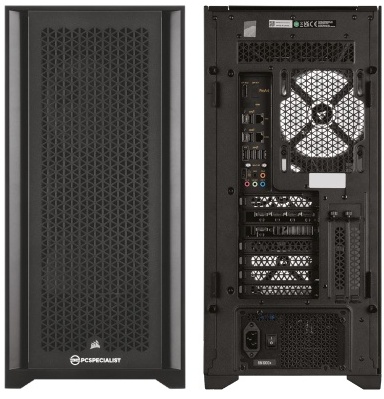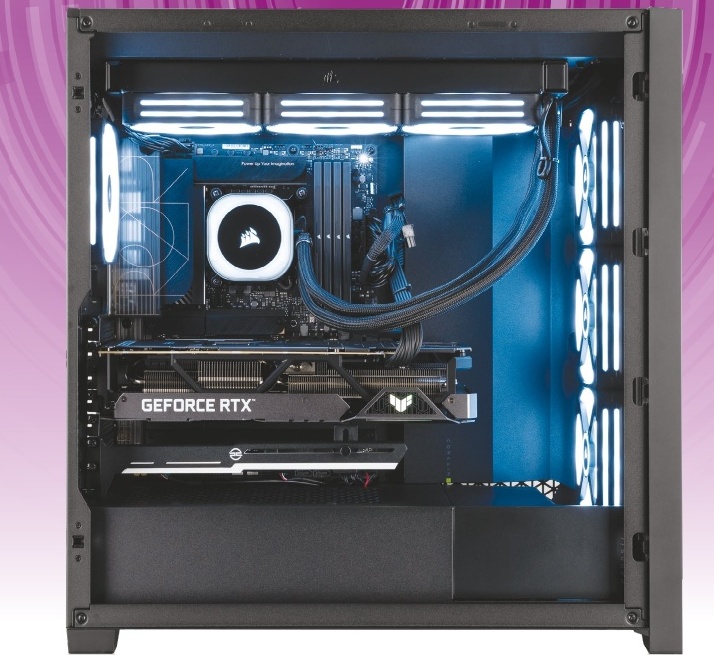Why you can trust TechRadar
This review first appeared in issue 361 of PC Pro.
PCSpecialist’s Quantum Goliath R is an outlier in this group test of workstations, as one of two systems supplied with consumer-grade rather than professional graphics. But that doesn’t mean it’s just a gaming PC. Certain types of content creators – particularly game developers – prefer this anyway.
The GPU in question is an incredibly potent Asus TUF GeForce RTX 4090 OC Edition. This sports 16,384 CUDA cores, which is almost as many as the Nvidia RTX 6000 Ada Generation and more than any other Nvidia card here. There’s 24GB of GDDR6X memory with 1,008GB/sec of bandwidth, which is also the highest in the Labs.
PCSpecialist has also gone for the best with the CPU, an Intel Core i9-14900KS. That’s one rung up from the 14900K provided by InterPro. The 14900KS similarly provides eight P-cores (with multithreading) and 16 E-cores (without) and has the same 3.2GHz base clock for the P-cores, with 2.4GHz for the E-cores. However, the P-cores go all the way up to 6.2GHz in Thermal Velocity Boost mode, compared to 6GHz for the 14900K, and the E-cores will hit 4.5GHz instead of 4.4GHz.
The memory allocation is also surprisingly high for a system in this price bracket – 192GB in total, made up of four 48GB DDR5 DIMMs running at 5,200MHz. That leaves no room for upgrades on the Asus ProArt Z790-Creator WiFi motherboard, but you won’t need to anyway.
Like PCSpecialist’s more expensive entry this month, the Quantum Goliath R opts for a fast boot drive and slower but more capacious data drive. In fact, they’re the same drives as the Zircon Extreme. The 4TB Samsung 990 Pro NVMe M.2 device for operating system and apps runs at PCI Express 4 speeds to deliver sustained reading of 7,132MB/sec and sustained writing of 6,846MB/sec with CrystalDiskMark 8. The larger 10TB data drive is a Seagate IronWolf Pro, aimed at business-grade use. This 7,200rpm SATA disk provides reading at 268MB/sec and writing at 264MB/sec – fast for a mechanical disk but pedestrian compared to any SSD.

These components are integrated into a Corsair 5000D Airflow chassis. This is a nice-looking case but relatively orthodox in design, with a tempered glass side. It’s designed for maximum airflow (hence the name) and has mounts for up to four 2.5in SSDs and two 3.5in drives. PCSpecialist has included a 1,000W Corsair RMx Series PSU, which is reassuring considering how much electricity the graphics card on its own will draw at full pelt.
The Quantum Goliath R makes good use of its Intel Core i9’s performance. The PC Pro media benchmarks score of 841 isn’t far off that provided by the 32-core AMD Ryzen Threadripper systems this month, and way ahead of other PCs in the £4,500 price category. The image-editing result of 306 was second fastest, while 816 in video encoding was only beaten by the monster 64-core Armari system. A multitasking score of 1,035 was very close to 32-core systems. With 24 cores and 32 threads, the Core i9 managed only 2,092 in Maxon Cinebench 2024 multi-CPU rendering, but that was the best in this price category, although the Blender Gooseberry render took 318 seconds, notably behind Armari’s £4,500 system.
The consumer-grade graphics have strengths and weaknesses. With the 3D animation workloads in SPECviewperf 2020 it flies, delivering 308 in 3dsmax-07 and 893 in maya-06. However, it’s not so great for CAD or engineering. While 166 in catia-06 and 162 in creo-03 are good, and 738 in solidworks-07 is superb, 54 in snx-04 is about ten times slower than a professional card.
The GPU compute tests show the full power of this accelerator, however, with a massive 34,082 in the Geekbench ML AI inference test and 31,154 with LuxMark 3.1 OpenCL. The Blender Gooseberry frame rendered in just 61 seconds with CUDA, which is the quickest we’ve ever seen.
The PC Specialist Quantum Goliath R is best avoided with this graphics choice if you run Siemens NX software. But if you’re a game developer, SolidWorks CAD creative or 3D animator, the performance, huge memory and capacious storage make it highly recommended.
Tim Danton is editor-in-chief of PC Pro, the UK's biggest selling IT monthly magazine. He specialises in reviews of laptops, desktop PCs and monitors, and is also author of a book called The Computers That Made Britain.
You can contact Tim directly at editor@pcpro.co.uk.
What is a hands on review?
Hands on reviews' are a journalist's first impressions of a piece of kit based on spending some time with it. It may be just a few moments, or a few hours. The important thing is we have been able to play with it ourselves and can give you some sense of what it's like to use, even if it's only an embryonic view. For more information, see TechRadar's Reviews Guarantee.

